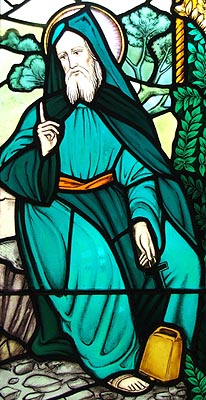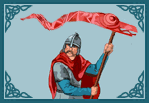|
|
|
 St. Beuno Gasulsych
St. Beuno Gasulsych
(Died AD 642)
(Latin: Bonus; English: Bono)
St. Beuno was born around AD 555, the son of Bugi ap
Gwynllyw and Princess Peren,
daughter of King
Letan Luyddoc of Gododdin. His paternal grandfather was a
minor Prince of Powys (the son of Tegid ap
Cadell Ddyrnllug) and, in this area, Beuno was raised.
The young Beuno was sent to Caerwent, in the south, to be educated by
St. Tathyw, in the college founded
by King Ynyr
Gwent there. Here he "obtained a knowledge of all the Holy
Scriptures. Afterwards he learned the service of the Church and its rules
and took orders and became a priest." It is said that Ynyr Gwent
himself, in his old age, granted Beuno lands in Ewyas and that he became
his disciple. This is now Llanfeuno, a chapelry under Clodock, near
Longtown in Herefordshire. Whilst there, Beuno heard that his father was
ill so he committed his foundation in Ewyas to three of his disciples, and
hurried back to Powys, where, "his father, after receiving communion,
making his confession and rendering his end perfect, departed this
life." Beuno made a foundation there on the spot and planted an acorn
by his father's grave. It grew into a mighty tree of which one branch
curved down to the ground and then rose again "and there was a part
of this branch in the soil, as at present; and if an Englishman should
pass between this branch and the trunk of the tree, he would immediately
die; but should a Welshman go, he would in no way suffer."
Next, Beuno was granted land at Berriew, near Welshpool, in
Montgomeryshire. A standing stone called the 'Maen Beuno' marks the spot
where he is said to have preached to the people. One day, however, when he
was walking by the Severn, he heard the hunting cries of an Englishman
from across the river and he went to his disciples and said: "My
sons, put on your clothes and shoes and let us leave this place, for the
nation of the man with the strange language, whose cry I heard beyond the
river urging on his hounds, will invade this place and it will be theirs,
and they will hold it as their possession."
Beuno therefore commended his foundation at Berriew to a disciple named
Rhithwlint, and travelled to Meifod to visit St.
Tysilio and the Royal Court. stayed for some forty days and
nights, after which King Cynan Gawyn
gave him lands in Meirionydd, at Gwyddelwern, near Corwen. Gwyddelwern
implies the site of an Irish settlement, but the saint's biography says
that it was so called because Beuno raised an Irishman back to life there.
This was probably Llorcan Wyddel, mentioned as one of the six persons said
to have been raised by him. Beuno did not stay long on this spot, because
of trouble with Cynan's grandsons, the sons of Prince Selyf
Sarffgadau, who came and demanded food for themselves and their
party. Beuno killed a young ox for them, but they complained that he had
bewitched the food. When he heard this, he cursed the young men, saying:
"What your grandfather gave to God free, do you demand of it tribute
and service? May your kin never possess the land, and may you be destroyed
out of this kingdom and be likewise deprived of your eternal
inheritance." Truly it was a risky thing to interfere with these old
Celtic saints! The real facts seem to have been that the young men claimed
food and shelter as a right, such as they could demand of any lay
householder in the tribe; but this was precisely a claim from which the
ecclesiastics considered themselves to be exempt.
As a result of this event, Beuno left Meirionydd and went back to Powys,
to what is now Flintshire. His brother, Tyfid, was living here, with his
wife and young daughter, and Beuno offered to become the latter's teacher
in return for some land on which to build a place of worship. He was given
the lordship of Abeluyc (Trefynnon alias Holywell) and, there,
daily instructed the girl, Gwenfrewy (alias
Winifred), in the ways of the Christian Church. She secretly took the veil
but her chosen path was not to run smoothly. While everyone was at church
one day, Gwenfrewy was troubled by the unwelcome attentions of a
libidinous huntsman. When rejected, he chased the girl to the church steps
and chopped off her head! Rushing from within, Beuno cursed the hunter
and, picking up his niece's head, he replaced it on her shoulders.
Miraculously, she was restored to life.
Upon Beuno's advice, Gwenfrewy set up the first nunnery in Britain, while
he decided it was best to depart for Ireland. She regularly worked him a
chasuble or some other pretty piece of needlework and had a stream carry
it to him. However, about the year AD 612, King
Cadfan of Gwynedd died and Beuno thought it might be politique to
pay his respects to the new monarch, Cadwallon.
Beuno made the King a present of a golden sceptre which had been given to
him by Cynan Garwyn of Powys. In return, Cadwallon gave the holyman a
patch of land at Gwredog in Arfon and, there, the saint built a church.
Whilst he was enclosing his new foundation with an earthen bank, a woman
came with a baby and asked the saint to bless it. "Presently,"
he replied, "as soon as this job is finished." But the child's
cries disturbed him so much that he asked the woman why her baby was
squealing all the time. "He has good reason," replied the
mother, "for you are enclosing land that belonged to his father and
is properly his." On hearing this, Beuno shouted to his monks:
"Leave off this work, and, whilst I baptise this child, make my
chariot ready. We will go to the King with this woman and child."
So they went to see Cadwallon at nearby Caer-Segeint (Caernarfon) and
Beuno said to him: "Why did you give me the land when it was not
yours to give, but belonged to this child? Give me other land, or else,
return to me the gold sceptre worth sixty cows that I gave to you."
"I will give you nothing else," replied the King, "and as
for the sceptre, I have already given it away." Then Beuno in great
wrath, cursed Cadwallon:
"I pray to God that you may not long possess the land." And then
he left.
However, when Beuno had crossed the River Saint, he sat on a stone and a
cousin of Cadwallon's caught up with him. His name was Gwyddaint and
"for his own soul and that of Cadwallon" he offered him his own
township of Clynnog "without tribute or service, or any one having
any claim on it." Beuno readily accepted and, from then onwards,
Clynnog became his main abode. It is beautifully situated on the north
coast of Lleyn, under the mountains of BwIch Mawr and Gyrn Ddu.
Now it happened that a skilled and handsome young carpenter from Aberffraw
was invited to Caerwent, to build a palace there. Whilst he was there,
Tigiwg the daughter of Ynyr, the king, fell in love with him and
accompanied him on his journey back home. But the carpenter was not
particularly amorous, or was ashamed of taking a princess to his native
hovel, and on the way back he murdered her, or so the legend says. She was
found by Beuno's Shepherds who reported the matter to the saint. He
resuscitated her and induced her to lead the religious life. (It is
possible that she was simply deserted, rather than killed, by the
carpenter). After a while, rumour of what had happened reached Caerwent,
and Iddon, her brother, came in search
of her. His sister, however, refused to return, either from a preference
for the religious life or from fear of having made far too great a fool of
herself over the carpenter. Her brother accepted this, but he asked Beuno
to go with him to Aberffraw to support his claim for the "horses and
gold and silver" which the carpenter had carried off along with his
sister. Beuno agreed to this and off they went to the court of Cadwallon
of Gwynedd at Aberffraw. As soon as Iddon set eyes on the young carpenter,
he drew his sword and would have killed him but for those who were
standing nearby holding him back. (A story that Iddon cut off the
carpenter's head, and that Beuno replaced it, is no doubt a later
mediaeval embellishment.) At first Cadwallon refused to have the goods
restored, but Beuno insisted and the King, perhaps afraid of incurring
another curse, gave way. He also gave Beuno the palace called Aelwyd Feuno.
Beuno returned to Clynnog, well content, and remained there the rest of
his days, dying on 21st April AD 642.
St. Beuno was buried in a chapel on the south-west side of the church. It
is said to have been destroyed by those searching for his relics. His holy
well, Ffynon Feuno, is about 200 yards from the church. In former days,
rickety and epileptic children, as well as impotent folk generally, were
dipped in it, and then carried to the chapel and put to lie overnight on
the saint's tombstone. If they slept, they would be cured. A custom that
survived until the early nineteenth century was one of making offerings of
calves and lambs which happened to be born with a slit in the ear,
popularly called Beuno's Mark. These "sacred beasts" were
brought to church on Trinity Sunday and the church-wardens who sold them
put the proceeds into Cyff Beuno (Beuno's chest). Into the chest also went
the offerings of persons who came from distant parts of the country, even
down to the early nineteenth century, to propitiate the saint on behalf of
their cattle when afflicted with some disorder. When the chest was opened
in December 1688, it contained £15.8.3d. The money was used for church
repairs and the relief of the poor.
Edited from Baring-Gould & Fisher's "Lives of the British Saints" (1907).
Records of St. Beuno date back to the 12th century. He is generally considered historic.
|
 |







 St. Beuno Gasulsych
St. Beuno Gasulsych